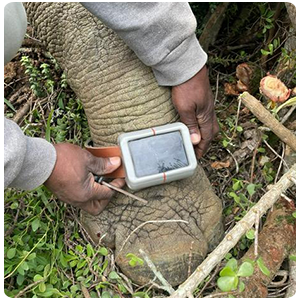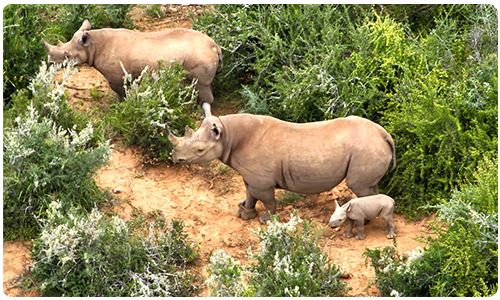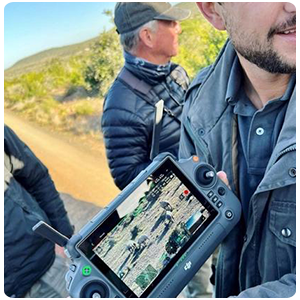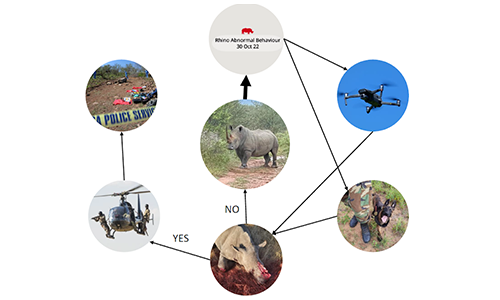Smart Collars and Rhino Conservation

This blog was written by IRF partners in South Africa

Many rhino-carrying reserves in South Africa, particularly the Eastern Cape, have partnered with Rouxcel Technology, a conservation company specializing in the design and deployment of rhino collars which detect and transmit abnormal rhino behavior in real-time. The system consists of two main components, namely the AI-Enabled Rhino Collars and a private LoRa Network.
The Rouxcel collars are solar powered and can last many years without any maintenance, compared to regular collars which require replacement at least every two years. The collars communicate through a private LoRa-Rhino network which is simple to install and maintain. The base station is a small box with built-in antennas, a solar panel and batteries – no additional solar panels or heavy batteries are required. These base stations communicate to the EarthRanger platform via a cellular network.
The rhino collar design includes smart algorithms which continuously monitor the rhino’s individual behavior. If an abnormal behavior is detected, the collar sends an alert via the LoRa-Rhino network to the EarthRanger platform, pinpointing the incident location via GPS. Alert categories are grey, amber, or red based on the event probability, or level of deviation from the individual rhino’s baseline behavior.

For example, grey alerts are triggered by rhinos fighting or chasing each other (giving the ecological team the opportunity to respond quicker to treat injuries). Amber alerts are triggered by rhinos giving birth (allowing management teams to gather more accurate population information and intercalving records).Red alerts are most likely triggered when an animal is severely injured or has died from either natural causes or a poaching event. This enables the effective, real-time investigation of possible poaching incidents.
The collars also provide frequent location data which is used by our ecological team to monitor and manage our populations optimally, while protecting their habitat. These collars also give insights and data that were never available before, especially for black rhinos in the wild, such as social interaction following births and behavior following treatment.

Following an alert, an initial investigation is launched using a thermal imaging drone which flies to the coordinates of the alert. The overview supplied by the drone helps us determine the cause of the alert and coordinate a response. If a poaching incident is confirmed, the operation is scaled up to increase the chance of arrest and minimize the impact on the crime scene. The drone also increases safety for counter-poaching teams on the ground by providing oversight of real-time situations.
The system increases security efficiencies by focusing resources on animals showing abnormal behavior. This increases the chance of detecting serious threats such as poaching incidents, injuries, or natural mortalities. Prompt intervention also increases security. Furthermore, it becomes harder and riskier for poachers to find the rhinos. The system has increased the chance of arrest, as the time and location of the incident is communicated in real-time, allowing response teams to react immediately.

